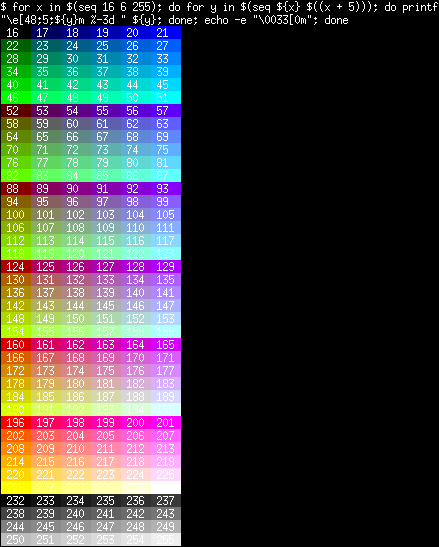Ansi colors
From Attie's Wiki
(Difference between revisions)
(Created page with "==Print a palette== Run this in bash: <source lang="bash"> for x in 4 10; do for y in $(seq 0 7); do echo -en "\0033[${x}${y}m "; done; echo -e "\0033[0m"; done </source>") |
m (→256-color) |
||
| (11 intermediate revisions by one user not shown) | |||
| Line 1: | Line 1: | ||
==Print a palette== | ==Print a palette== | ||
| − | + | These palettes are generated from a 'clean' installation of XTerm (with no configuration). | |
| + | |||
| + | === 16-color === | ||
<source lang="bash"> | <source lang="bash"> | ||
for x in 4 10; do for y in $(seq 0 7); do echo -en "\0033[${x}${y}m "; done; echo -e "\0033[0m"; done | for x in 4 10; do for y in $(seq 0 7); do echo -en "\0033[${x}${y}m "; done; echo -e "\0033[0m"; done | ||
</source> | </source> | ||
| + | [[File:xterm-palette.png]] | ||
| + | |||
| + | Some of these colors aren't good, and I prefer to use another. See the [[Xresources]] page for implementation of this. | ||
| + | {| class="wikitable" | ||
| + | ! Brightness !! # !! ## !! Color !! Value !! Attie's Preferred | ||
| + | |- | ||
| + | |rowspan="8"| Normal || 0 || 0 || Black ||style="background-color:#000000;color:#FFF;"| #000000 || ← | ||
| + | |- | ||
| + | | 1 || 1 || Red ||style="background-color:#CD0000;"| #CD0000 || ← | ||
| + | |- | ||
| + | | 2 || 2 || Green ||style="background-color:#00CD00;"| #00CD00 || ← | ||
| + | |- | ||
| + | | 3 || 3 || Yellow ||style="background-color:#CDCD00;"| #CDCD00 || ← | ||
| + | |- | ||
| + | | 4 || 4 || Blue ||style="background-color:#0000EE;color:#FFF;"| #0000EE || ← | ||
| + | |- | ||
| + | | 5 || 5 || Magenta ||style="background-color:#CD00CD;"| #CD00CD || ← | ||
| + | |- | ||
| + | | 6 || 6 || Cyan ||style="background-color:#00CDCD;"| #00CDCD || ← | ||
| + | |- | ||
| + | | 7 || 7 || White ||style="background-color:#E5E5E5;"| #E5E5E5 || ← | ||
| + | |- | ||
| + | |rowspan="8"| Bright || 0 || 8 || Black ||style="background-color:#7F7F7F;color:#FFF;"| #7F7F7F || ← | ||
| + | |- | ||
| + | | 1 || 9 || Red ||style="background-color:#FF0000;"| #FF0000 || ← | ||
| + | |- | ||
| + | | 2 || 10 || Green ||style="background-color:#00FF00;"| #00FF00 || ← | ||
| + | |- | ||
| + | | 3 || 11 || Yellow ||style="background-color:#FFFF00;"| #FFFF00 ||style="background-color:#D78700;"| #D78700 | ||
| + | |- | ||
| + | | 4 || 12 || Blue ||style="background-color:#5C5CFF;color:#FFF;"| #5C5CFF || ← | ||
| + | |- | ||
| + | | 5 || 13 || Magenta ||style="background-color:#FF00FF;"| #FF00FF || ← | ||
| + | |- | ||
| + | | 6 || 14 || Cyan ||style="background-color:#00FFFF;"| #00FFFF || ← | ||
| + | |- | ||
| + | | 7 || 15 || White ||style="background-color:#FFFFFF;"| #FFFFFF || ← | ||
| + | |} | ||
| + | |||
| + | === 256-color === | ||
| + | The colors before #16 are the same as above. | ||
| + | <source lang="bash"> | ||
| + | for x in $(seq 16 6 255); do for y in $(seq ${x} $((x + 5))); do printf "\e[48;5;${y}m %-3d " ${y}; done; echo -e "\0033[0m"; done | ||
| + | </source> | ||
| + | [[File:xterm-palette-256.png]] | ||
Latest revision as of 12:13, 14 March 2013
[edit] Print a palette
These palettes are generated from a 'clean' installation of XTerm (with no configuration).
[edit] 16-color
for x in 4 10; do for y in $(seq 0 7); do echo -en "\0033[${x}${y}m "; done; echo -e "\0033[0m"; done
Some of these colors aren't good, and I prefer to use another. See the Xresources page for implementation of this.
| Brightness | # | ## | Color | Value | Attie's Preferred |
|---|---|---|---|---|---|
| Normal | 0 | 0 | Black | #000000 | ← |
| 1 | 1 | Red | #CD0000 | ← | |
| 2 | 2 | Green | #00CD00 | ← | |
| 3 | 3 | Yellow | #CDCD00 | ← | |
| 4 | 4 | Blue | #0000EE | ← | |
| 5 | 5 | Magenta | #CD00CD | ← | |
| 6 | 6 | Cyan | #00CDCD | ← | |
| 7 | 7 | White | #E5E5E5 | ← | |
| Bright | 0 | 8 | Black | #7F7F7F | ← |
| 1 | 9 | Red | #FF0000 | ← | |
| 2 | 10 | Green | #00FF00 | ← | |
| 3 | 11 | Yellow | #FFFF00 | #D78700 | |
| 4 | 12 | Blue | #5C5CFF | ← | |
| 5 | 13 | Magenta | #FF00FF | ← | |
| 6 | 14 | Cyan | #00FFFF | ← | |
| 7 | 15 | White | #FFFFFF | ← |
[edit] 256-color
The colors before #16 are the same as above.
for x in $(seq 16 6 255); do for y in $(seq ${x} $((x + 5))); do printf "\e[48;5;${y}m %-3d " ${y}; done; echo -e "\0033[0m"; done
